Markeb, Kappa Velorum (κ Vel), is a spectroscopic binary star located 570 light years away in the southern constellation Vela. With an apparent magnitude of 2.48, it is the fourth brightest star in Vela, after Regor, Alsephina, and Suhail. Markeb is one of the four bright stars that form the False Cross, a prominent southern asterism often mistaken for the Southern Cross.
Star system
Kappa Velorum is a spectroscopic binary system with the combined stellar classification B2 IV, indicating a blue subgiant. The two stars orbit each other with a period of 116.65 days. The individual components have not been resolved. Kappa Velorum has an estimated radius 6.9 times that of the Sun.
Facts
Markeb is the faintest of the four stars of the False Cross, a bright diamond-shaped asterism in the far southern sky. The other three stars that form the asterism are Avior (Epsilon Carinae) and Aspidiske (Iota Carinae) in the constellation Carina and Alsephina (Delta Velorum) in Vela. The False Cross is larger and fainter than the Southern Cross, with which it is often confused. Formed by the brightest stars of the constellation Crux, the Southern Cross is used to find true south and not distinguishing between the two asterisms can lead to errors in navigation. The easiest way to tell them apart is using the Southern Pointers, Alpha and Beta Centauri. The two first-magnitude stars point toward Gacrux, the star at the top of the Southern Cross.
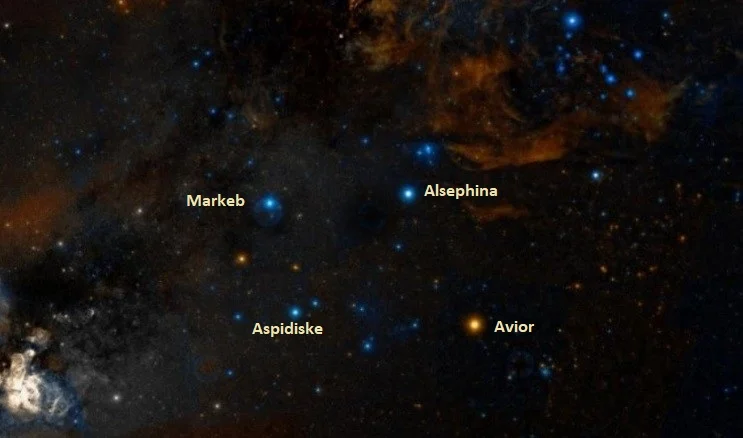
The False Cross, image: Wikisky
Name
The name Markeb (pronunciation: /ˈmɑːrkɛb/) comes from the Arabic markab, meaning “something to ride.” It has the same etymology as Markab (Alpha Pegasi). The alternative and often used spelling Markeb was approved by the International Astronomical Union (IAU) to distinguish between the two stars. The name was approved by the IAU’s Working Group on Star Names (WGSN) on September 5, 2017.
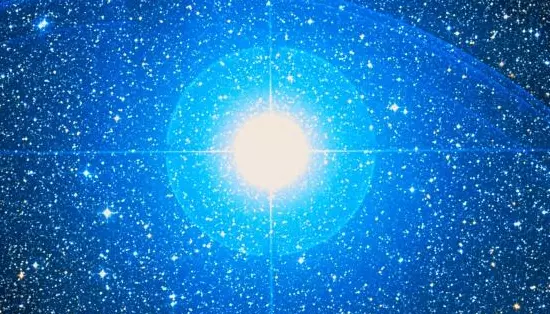
Markeb (Kappa Velorum), image: Wikisky
In Chinese astronomy, Kappa Velorum was known as 天社五 (Tiān Shè wǔ), the Fifth Star of Celestial Earth God’s Temple. The star was part of an asterism known as Celestial Earth God’s Temple along with Alsephina (Delta Velorum), Regor (Gamma2 Velorum), b Velorum, Phi Velorum, and N Velorum. The star pattern is part of the larger Ghost mansion, one of the southern mansions of the Vermilion Bird.
Location
Markeb is easy to find because it is part of a prominent southern asterism, the False Cross. It is the faintest of the four stars and the farthest one from Canopus, the second brightest star in the sky, which lies in the same area.
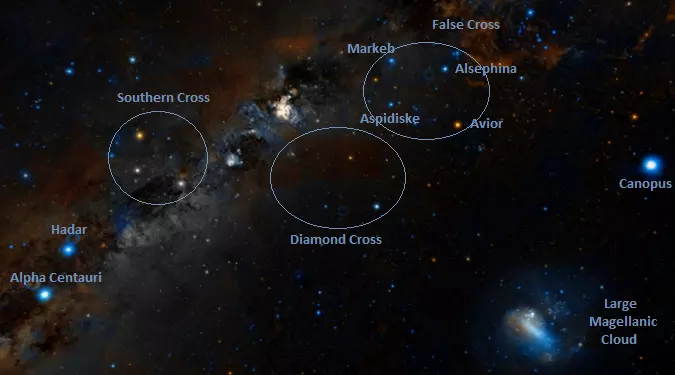
Location of Alsephina, Avior, Markeb and Aspidiske, image: Wikisky
Markeb can be used to find NGC 2899 (Gum 27), a planetary nebula that lies between Kappa and N Velorum (HD 82668). The nebula has an apparent magnitude of 11.8 and lies almost 6,500 light years away.
A line extended from Markeb through Aspidiske leads to the globular cluster NGC 2808 in Carina. The cluster has an apparent magnitude of 6.2 and lies 31,300 light years away. It is one of the most massive clusters in the Milky Way.
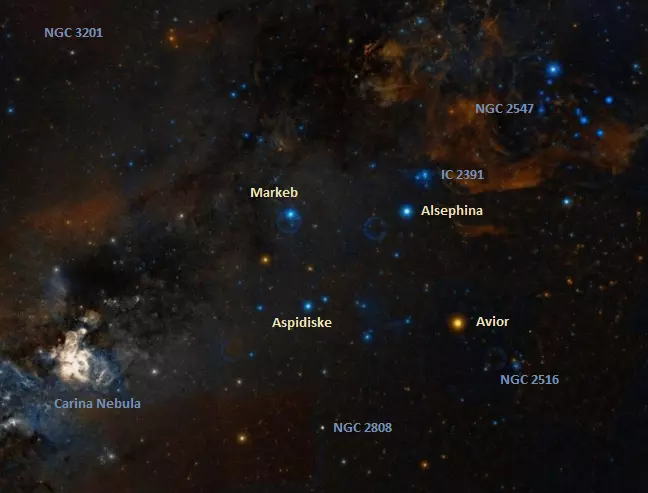
Deep sky objects near the False Cross, image: Wikisky
Constellation
Markeb is located in the southern constellation Vela. Representing the sails of the ship Argo, on which Jason and the Argonauts sailed to Colchis on their quest to find the Golden Fleece, Vela was once part of the larger constellation Argo Navis, which represented the mythical ship. Argo Navis was divided into Carina (the Keel), Puppis (the Stern) and Vela (the Sails) by the French astronomer Nicolas-Louis de Lacaille in the 18th century.
Vela stretches across 500 square degrees and is the 32nd largest constellation in the sky. With five stars brighter than magnitude 3.00, it is fairly bright. Two of these stars – Markeb and the brighter Alsephina – are part of the False Cross, a conspicuous asterism in the far southern sky.
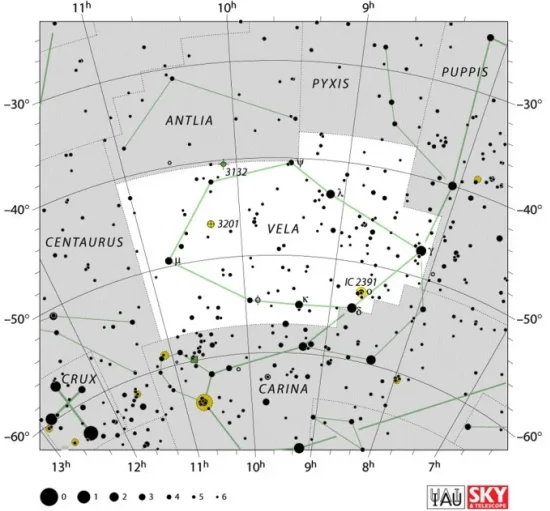
Vela constellation map by IAU and Sky&Telescope magazine
Vela is home to several notable stars. These include Regor (Gamma Velorum), the constellation’s brightest star and the nearest Wolf-Rayet star to the Sun, Alsephina (Delta Velorum), one of the brightest eclipsing binary stars in the sky, the orange supergiant Suhail (Lambda Velorum), the Cepheid variable AH Velorum, and the blue giant Omicron Velorum, the brightest star in the open cluster IC 2391, which is visible to the unaided eye on a clear night. The constellation also contains the binary brown dwarf Luhman 16, the third closest star system to the Sun.
Bright deep sky objects in Vela include the Eight-Burst Nebula (NGC 3132), a planetary nebula also known as the Southern Ring Nebula, the planetary nebula NGC 2899 near Markeb, the emission nebulae Gum 20 and Gum 12 (the Gum Nebula), the latter of which contains the Vela Supernova Remnant, the bright open cluster IC 2391 (the Omicron Velorum Cluster), and the globular cluster NGC 3201.
The best time of year to observe the stars and deep sky objects of Vela is during the month of March, when the constellation is high above the horizon in the evening sky. The entire constellation is visible from locations between the latitudes 30° N and 90° S.
The 10 brightest stars in Vela are Gamma2 Velorum (mag. 1.83), Alsephina (Delta Vel, mag. 1.96), Suhail (Lambda Vel, mag. 2.21), Markeb (Kappa Vel, mag. 2.48), Mu Velorum (mag. 2.69), N Velorum (HD 82668, mag. 3.16), Phi Velorum (mag. 3.53), Omicron Velorum (mag. 3.60), c Velorum (HD 78004, mag. 3.75), and b Velorum (HD 74180, mag. 3.81).
Markeb – Kappa Velorum
| Spectral class | B2 IV |
| U-B colour index | -0.78 |
| B-V colour index | -0.20 |
| Apparent magnitude | 2.48 |
| Absolute magnitude | -3.74 |
| Distance | 570 ± 30 light years (175 ± 9 parsecs) |
| Parallax | 5.70 ± 0.30 mas |
| Radial velocity | 21.9 ± 0.9 km/s |
| Proper motion | RA: -11.40 ± 0.32 mas/yr |
| Dec.: +11.52 ± 0.27 mas/yr | |
| Constellation | Vela |
| Right ascension | 09h 22m 06.8176100s |
| Declination | –55° 00′ 38.401683″ |
| Names and designations | Markeb, Kappa Velorum, κ Vel, HD 81188, HR 3734, HIP 45941, SAO 236891, CPD-54°2219, FK5 353, GC 12938, GCRV 6104, PPM 337874, PLX 2237.00, ALS 14934, JP11 1809, GSC 08588-04200, IRAS 09205-5447, 2MASS J09220681-5500386, UBV 8967, TYC 8588-4200-1 |